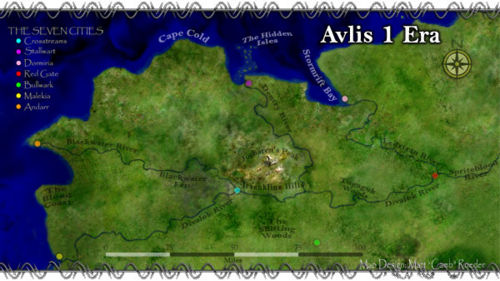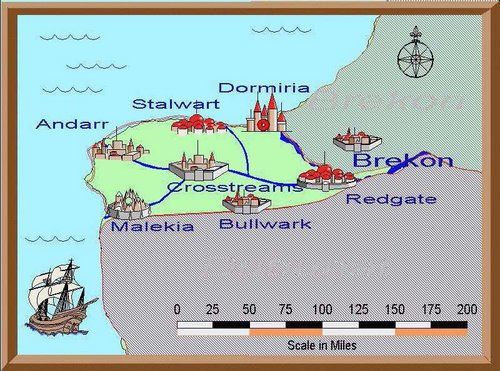The Seven Cities: Difference between revisions
| Line 14: | Line 14: | ||
==General Information== | ==General Information== | ||
'''Current Ruler:''' | '''Current Ruler:''' Lord Heiram Sleighton (Governor of Crosstreams) | ||
'''Capitol:''' Crosstreams | '''Capitol:''' Crosstreams | ||
Revision as of 00:58, 26 May 2016


“No place is home to more beauty and more squalor, more virtue and vice, more good and evil than the Seven Cities. It is where diplomats, soldiers, merchants and wanderers make their home away from home. It is a place for new beginnings, old friendships and converging paths. This is the Seven Cities.” –Khaled Thamaea, A Chronicler’s Tales of the Confederation
The Seven Cities Confederation known colloquially as The Seven Cities is a collection of semi-autonomous city-states located on the western coast of Negaria. The Confederation sits at the cross-roads of Negaria, where individuals from all over the world gather in pursuit of their ambitions. Each of the Seven Cities represents a distinct synthesis of regional cultures and their uneasy internal politics is a microcosm of the continent as a whole. Filled with opportunities and pitfalls, the Seven Cities Confederation is the destination of adventurers, gamblers and those simply looking for a new way of life.
General Information
Current Ruler: Lord Heiram Sleighton (Governor of Crosstreams)
Capitol: Crosstreams
Major Faiths: Nearly every faith on Avlis is represented in The Seven Cities
Government: Confederation
Territorial Area: 15,000 sq. miles/39,000 km2
Population: 6,384,000; 30% Human, 20% Orc, 25% Various Half-Races (Half-Fey, Half-Orc, Half-Elf, etc.), 10% Dwarven, 5% Gnomish, 5% Elven, 10% Other
Languages: Confederate Common, Royal Dobrekanic
Trade: Exports – Manufactured Goods; Imports – Grains, foodstuffs, livestock, raw materials.
Alliances/Trading Partners: Brekon – Trading Partner, Kurathene remnants – Trading Partner
Army: Army Corps of Bullwark, Andarr Confederate Navy
History of The Seven Cities
The region that is now occupied by The Seven Cities remained sparsely populated early in the history of the mortal races. Sporadic populations and villages emerged after the orcs had been driven to the west coast during The Great War, however the region around the Divalok River, upon which the confederation rests, was never heavily populated, as the Golden Scythe tended to offer a climate more comfortable for the orcs.
Settlement of the banks of the Divalok River began in earnest around the 3rd century as the rise of The’ton in Dubunat and the losses incurred by the Kurathene Empire along its land routes gave its maritime trade a much greater importance. The Divalok River was thought to be the most suitable location for a centralized port from which naval trade of the Kurathene could flourish because of its natural depth. Starting in 317 O.D., the emperor gave out six imperial charters to the six most prominent noble families involved in foreign trade: the Tochi’larian, Arvanos, Crullath, Clairvont, Al’Aere, and Tyeduan families, who established the cities of Andarr, Dormiria, Red Gate, Stalwart, Bullwark, and Conselia (later Malekia) respectively.
The volume of trade among these colonies grew exponentially as the years progressed, and in the 7th century the city of Crosstreams was founded in the center of the Divalok River to better facilitate organization among the various trade guilds and merchants that operated in the rigion. The cities began to attract more foreign shipping and merchants, as the size and profitability of the ventures committed there rose with every passing year.
This also meant the locals gradually began to assimilate more foreign influences. Everything from racial customs, such as those brought by the dwarven, elven, and gnomish immigrants, to acceptance of foreign religions such as Maleki and The Harpinger was incorporated into the existing culture. Each of the Seven Cities began to develop its own distinct cultural identity detached from the Kurathene Empire, and as the population diversified and grew, the percentage of humans originally from Kurathene plummeted dramatically.
Taking advantage of the momentary weakness of the Kurathene Empire in the 14th century A.O.D., each of the Seven Cities officially declared its independence from the Empire, with Conselia changing its name to Malekia, and each adopting a new and independent form of government distinctly different from its predecessor. The fact that many of the Empire’s legions had been exhausted during the wars with Dubunat and Tyedu forced it to acknowledge its cities’ independence.
The cities originally were content to consider themselves independent city-states with no central obligation to one another. However frequent attempts by both Dubunat and Brekon to annex them began to increase the necessity for a full-fledged confederacy. Thus in 1520 The Seven Cities formed a confederacy, with Bullwark becoming the acknowledged center for the new Confederate Army and Andarr the newly established navy.
Major Geographic Features
The Seven Cities occupies such a small stretch of land that it does not have any particularly striking geographic features aside from the Divalok River .
Divalok River
The Divalok River refers to the multiple river branches that flow within the confines of the confederacy. It is actually a tributary of the Spriteblood River that flows between Dubunat and Brekon, and thus is able to carry a great deal of river traffic from both nations. It is naturally deep and capable of supporting some of the largest merchant ships in service, and the extensive canals that have been dug by each of the cities in the confederation allow it to be used as the primary form of transportation within the region.